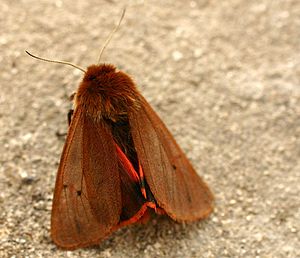Cinnamon bear
| Cinnamon bear | ||||||||||||
|---|---|---|---|---|---|---|---|---|---|---|---|---|

Cinnamon Bear ( Phragmatobia fuliginosa ) |
||||||||||||
| Systematics | ||||||||||||
|
||||||||||||
| Scientific name | ||||||||||||
| Phragmatobia fuliginosa | ||||||||||||
| ( Linnaeus , 1758) |
The cinnamon bear or rust-winged bear ( Phragmatobia fuliginosa ) is a butterfly ( moth ) from the subfamily of the bear moth (Arctiinae).
description
The moths reach a wingspan of 30 to 35 millimeters. The top of the wing is cinnamon-colored and has a small black dot in the middle. However, the shade of brown often varies considerably, from light brown to dark reddish brown. The hind wings are colored bright dark red and show black points of varying strength. The warning color “red with dots” is repeated on the body. The warning sign is intended to prevent birds from consuming this species ( aposematism ). Young birds learn to understand this warning at the latest when they try one of these moths, because they will spit it out again because it is inedible. The caterpillars are also inedible for birds.
The reddish egg is spherical and flattened at the bottom.
The caterpillars are about 35 millimeters long. They are colored black-gray and have dense tufts of red-brown or light gray-brown hair. A light yellowish vertical stripe runs along the back.
The blackish pupa has yellowish segment incisions.
Similar species
- Emperor Bear ( Phragmatobia luctifera Goeze, 1781)
habitat
The cinnamon bear can be found in meadows, pastures, on the edges of forests, in heathland and on wastelands all over Europe . In mountains it appears up to a height of 3000 meters. Since it has few enemies due to its inedibility and aposematism, only cold and rainy summers can afflict it, in which the moths are rarely found. But if the summer is warm and dry, it occurs frequently.
Flight and caterpillar times
In a year there are two generations. The first generation of the nocturnal moths can be found from mid-April to early June; the second generation, surprisingly more active in flight, from July to mid-August. The caterpillars can be found from September to early April and from June to July. The caterpillar overwinters.
Food of the caterpillars
The caterpillars feed on various herbaceous plants and shrubs, such as. B. Blackberries ( Rubus fruticosus ), blackthorn ( Prunus spinosa ), meadowsweet ( Filipendula ulmaria ), ribwort ( Plantago lanceolata ), Jacob's ragwort ( Senecio jacobaea ) and dandelion ( Taraxacum officinale ) and the like. v. a. Günter Ebert lists 21 different host plants.
By eating Alpendost ( Adenostyles ), coltsfoot ( Tussilago farfara ), ragweeds ( Senecio ) such as Jacob's ragwort and other alkaloid- containing plants, their toxin is absorbed and mainly as danaidal ( 2,3 ‐ dihydro ‐ 1H ‐ pyrrolizidine ‐ 7‐ carbaldehyde ) incorporated , making the way for many predators is inedible. The feeding of the larvae with pyrrolizidine alkaloids also helps the adult males to produce more pheromones .
development
To attract the females, the males protrude tube-like pheromone-containing organs ( coremata ) from their abdomen . The females lay the fertilized eggs in very large clutches of up to 500 next to each other on the underside of the leaves of the forage plants. The pupation of the caterpillars takes place directly after the wintering, sometimes you can find active animals very early even crawling around on the snow. They pupate in a gray-brown web, usually between leaves and parts of plants near the ground.
swell
literature
- Günter Ebert: The butterflies of Baden-Württemberg. Volume 5, Moth III. Ulmer Verlag, Stuttgart 1997, ISBN 3-8001-3481-0 .
- Manfred Koch : We determine butterflies. Volume 2: Bears, Spinners, Swarmers and Drills in Germany. 2nd, expanded edition. Neumann, Radebeul / Berlin 1964, DNB 452481929 .
- Walter Forster , Theodor A. Wohlfahrt : The butterflies of Central Europe. Volume 3: Weirdos and Swarmers. (Bombyces and Sphinges). Franckh'sche Verlagshandlung, Stuttgart 1960, DNB 456642196 , p. 239.
Web links
- schmetterling-raupe.de
- www.insektenbox.de
- www.rodeland.de ( Memento from May 13, 2005 in the Internet Archive )
- www.lepiforum.de
- Moths and Butterflies of Europe and North Africa (English)
- Phragmatobia fuliginosa in Fauna Europaea
Individual evidence
- ^ Günter Ebert: The butterflies of Baden-Württemberg. Volume 5, Moth III. Ulmer Verlag, Stuttgart 1997, ISBN 3-8001-3481-0 .
- ^ Sebastian EW Opitz, Caroline Müller: Plant chemistry and insect sequestration . In: Chemoecology , Volume 19, September 2009, p. 117.
- ↑ Stuart B. Krasnoff, Wendell L. Roelofs: Quantitative and qualitative effects of larval diet on male scent secretions of Estigmene acrea, Phragmatobia foliginosa, and Pyrrharctia isabella (Lepidoptera: Arctiidae) , In: Journal of Chemical Ecology , Volume 15, No. 3, March 1989, pp. 1077-1093.
- ↑ Stuart B. Krasnoff, Wendell L. Relofs: Evolutionary trends in the male pheromone systems of arctiid moths: evidence from studies of courtship in Phragmatobia fuliginosa and Pyrrharctia isabella (Lepidoptera: Arctiidae) . In: Zoological Journal of the Linnean Society , vol. 99, no. 4, August 1990, pp. 319-338, doi : 10.1111 / j.1096-3642.1990.tb00558.x .
